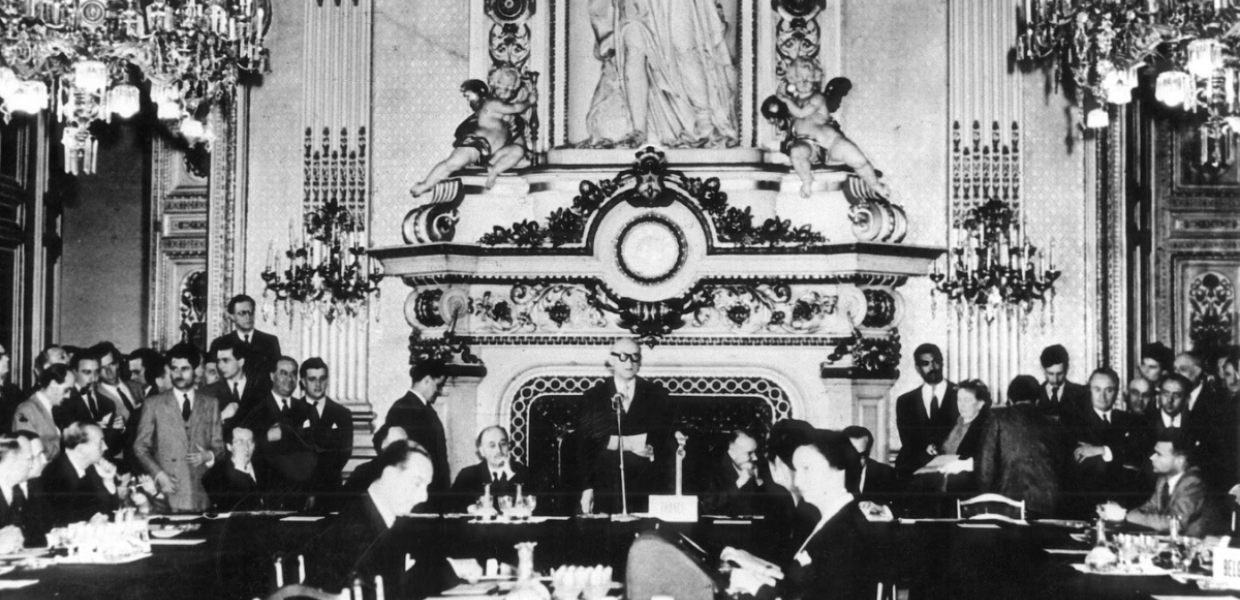European Parliament Archives brings Schuman Declaration to life in new exhibition with Europeana
As the COVID-19 crisis places pressure on the cultural heritage sector, institutions have been rising to the challenge by increasingly using digital means to engage with their audiences and communities. When a long-planned exhibition celebrating the 70th Anniversary of the Schuman Declaration could no longer take place in European cities, the European Parliament Archives worked with Europeana to bring the exhibition to life online – in 24 languages. We speak to Ludovic Delepine, Head of Archives at the European Parliament, about how it all came together.

- Title:
- Robert Schuman delivering his declaration in the Salon de l'Horloge in the French Foreign Ministry building at Quai d'Orsay in Paris on 9 May 1950. In copyright.
- Institution:
- European Union
Can you tell us about your work in the European Parliament Archives? What kind of collections do you have?
The archives store and preserve the historical documents of the European Parliament from 1952 onwards, in formats including paper, electronic, photographic and posters. My collaborators and I are responsible for keeping the evidence of the activity of the European Parliament, preserving the historical memory of the institution and making it accessible to citizens. This covers several areas including the acquisition of documents and stock management, the management of an archive information system, and promoting and sharing our assets through events, studies and exhibitions.
The last activity is an important professional dimension of the archives. Archiving is not only about acquisition, treatment and preservation. It is about contributing to history by facilitating the activities of historians, librarians, researchers, and of course, informing citizens.
Tell us about the exhibition! What material does it incorporate?
The exhibition tells the story of the declaration of the French Foreign Minister Robert Schuman on 9 May 1950, which marked the beginning of the process of building the European Community; 9 May is now celebrated annually as Europe Day. It incorporates photographs from European Union collections and private collections, many of which have not been publicly shared before; the exhibition is really unique in this way.
A huge amount of work went into preparing the exhibition, beginning December 2019. It is available in 24 languages, and we intended to share it on printed panels in 14 different cities in Europe.
Once it became apparent that the exhibition could not take place physically, what options did you consider?
Due to the disruptions of COVID-19, the premises where we had planned to present the exhibition will be closed to the public on 9 May, so we had to consider using alternative communication channels. The question of how to do this was initially raised by the European Parliament Liaison Office in Strasbourg. We invested a lot of time in the preparation of the exhibition and wanted to share it with European citizens and remind them of the spirit of our ‘founding fathers’ in this important moment.
So we had to reinvent ourselves. Traditionally we have produced physical exhibitions, rarely online exhibitions of this size. This was the perfect moment to ‘move digital’ and to develop new ways of sharing.
Tell us about the process of ‘moving digital.’
Considering the time left before 9 May, it was evident that we could not develop a professional solution to bring a digital exhibition to life ourselves, so we looked for the opportunity to share it through another platform. The choice of Europeana was simple - an online platform from the European Commission, which supports thousands of cultural heritage organisations in sharing their collections.
When I contacted Douglas McCarthy from the Collections Engagement team at Europeana, the co-operation was immediate. The images that were intended for the physical exhibition had already been digitised and we had established the necessary copyright information, as well as captions for the images. Additionally, the format in which we had designed the exhibition, divided up into panels, leant itself well to sharing as online ‘chapters.’
The Collections Engagement team were able to build the English version of the exhibition online in one day, and the 23 other languages were available in a week. The exhibition curator, Étienne Deschamps, then worked with the team to make minor changes, and the exhibition was ready in 20 calendar days. An exceptional quality of service from the Collections Engagement team–we couldn’t believe it!
How do you think that the exhibition being shared digitally will affect the audiences who access it?
The website of the Archives for the European Parliament is not visited often, but sharing our archives for education and reminding our citizens of their history is an important driver to sustain our democracies. Presenting the exhibition on Europeana will allow us to reach a wider audience–both online citizens and our peers in cultural heritage institutions.
How do you think that your ‘digital first’ experience of this exhibition will affect your work in the future?
This is a radical change in our approach. It is now not only about physical exhibitions, but will see digital and physical exhibitions as two complementary streams. With the support of the Collections Engagement team at Europeana, we have demonstrated that this is possible, and this is just the first step opening a long and fruitful collaboration with Europeana.
More generally, what role do you think that cultural heritage can play at this time?
Engaging with our cultural heritage reminds us what it means to be European citizens, and of the importance of solidarity in a crisis. For example, my favourite part of this exhibition focuses on reactions to the Schuman Declaration, because it highlights the support provided by six countries to build a common future. If we draw a parallel with the situation today, this is a kind of spirit we need to promote. Peace, solidarity and togetherness were key values that led to the Schuman Declaration, and we can continue to celebrate them through cultural heritage.

